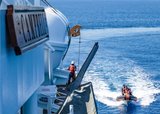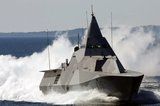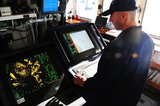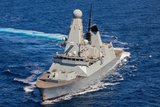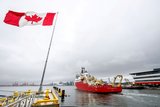InTop LLRAM demonstration completed
Northrop Grumman completed a critical test in the development of the Integrated Topside (InTop) Low-Level Resource Allocation Manager (LLRAM) programme in partnership with the US Naval Research Laboratory (NRL).
The LLRAM was demonstrated in conjunction with the the InTop Electronic Warfare/Information Operations/Communications (EW/IO/COMMS) system at the NRL’s test facility in Chesapeake Beach, Maryland.
The system demonstrated the simultaneous sharing of a single antenna, while flexing its adaptable size and antenna pattern capabilities, and performing a mission that would have previously required multiple dedicated antennas. The test was carried out as part of work to enable future antenna reductions on ships that are already capacity-constrained, allowing for more advanced capabilities in an ever-increasingly complex battlespace environment.
The demonstration showed that the EW/IO/COMMS Advanced Development Model for SEWIP Block 3 can serve as a platform for proving out advanced multi-function concepts using existing NRL test assets.
Mike Meaney, vice president, maritime electronic and information warfare, Northrop Grumman, said: ‘The Northrop Grumman/NRL demonstration of LLRAM concepts was conducted in the same environment that proved crucial to the development of the SEWIP Block 3 EDM.
‘The efficiency of signal sharing capabilities, scalability and advanced resource management capabilities developed on the LLRAM programme will allow for a significantly reduced footprint topside.’
The system leverages four AESA arrays (low band transmit/receive and high band transmit/receive) and intended platforms include cruisers, destroyers and aircraft carriers.
More from Naval Warfare
-
![Sweden’s decision on four new warships inches closer as it eyes UK, France and Spain]()
Sweden’s decision on four new warships inches closer as it eyes UK, France and Spain
Sweden decided last year that it wanted a significantly larger warship for its Luleå Class programme than originally planned, with three likely contenders that could potentially deliver within the country’s tight schedule.
-
![How the use of artificial intelligence will affect the US Coast Guard’s acquisitions]()
How the use of artificial intelligence will affect the US Coast Guard’s acquisitions
The USCG is pursuing AI tools to improve the way the service conducts its procurement and fielding processes.
-
![US Coast Guard prepares procurement of next-gen surface search radar]()
US Coast Guard prepares procurement of next-gen surface search radar
The NXSSR will replace five in-service capabilities and be the US Coast Guard’s primary collision avoidance system.
-
![MBDA-led DragonFire’s latest trials move the LDEW system closer to UK Navy integration]()
MBDA-led DragonFire’s latest trials move the LDEW system closer to UK Navy integration
The DragonFire lines up with other European laser-directed energy weapons being developed in collaboration with MBDA.
-
![Canadian Coast Guard’s OOSV delivery is “major milestone” in fleet modernisation]()
Canadian Coast Guard’s OOSV delivery is “major milestone” in fleet modernisation
The Polar Class 6 platform is the largest CCG science-dedicated vessel and will operate on the country’s east coast.







